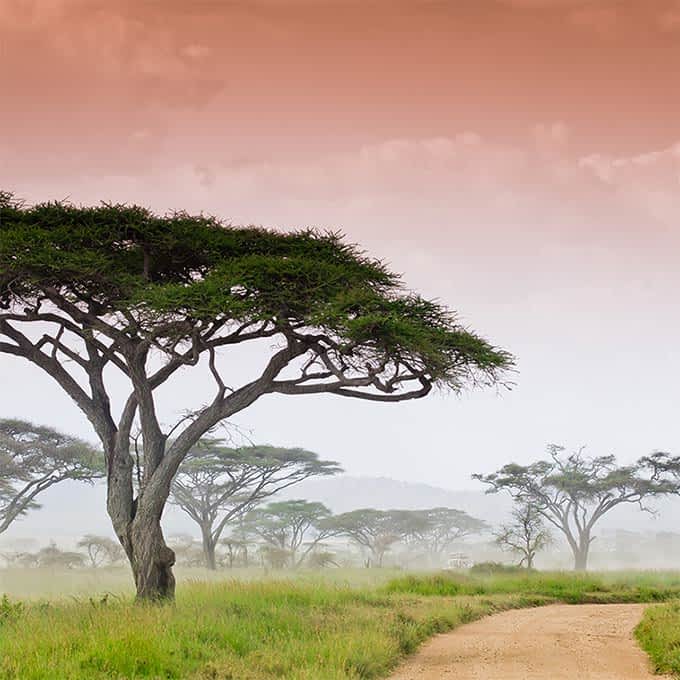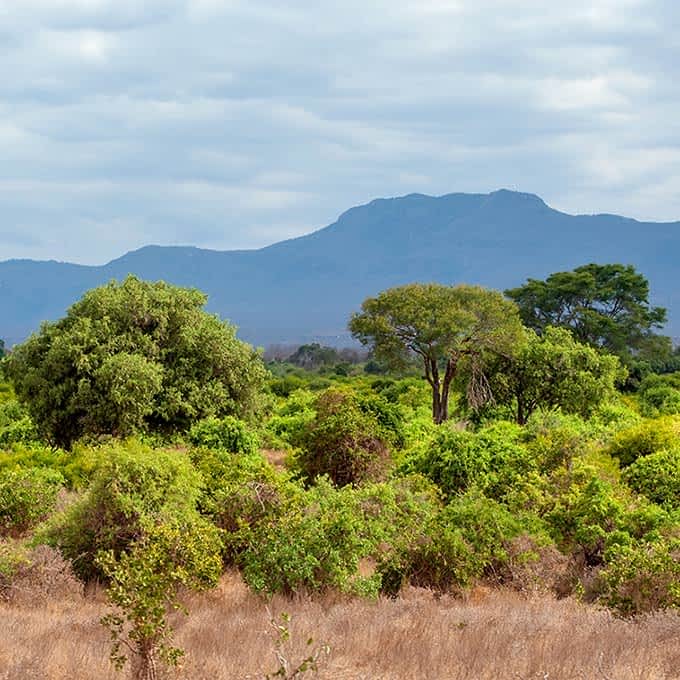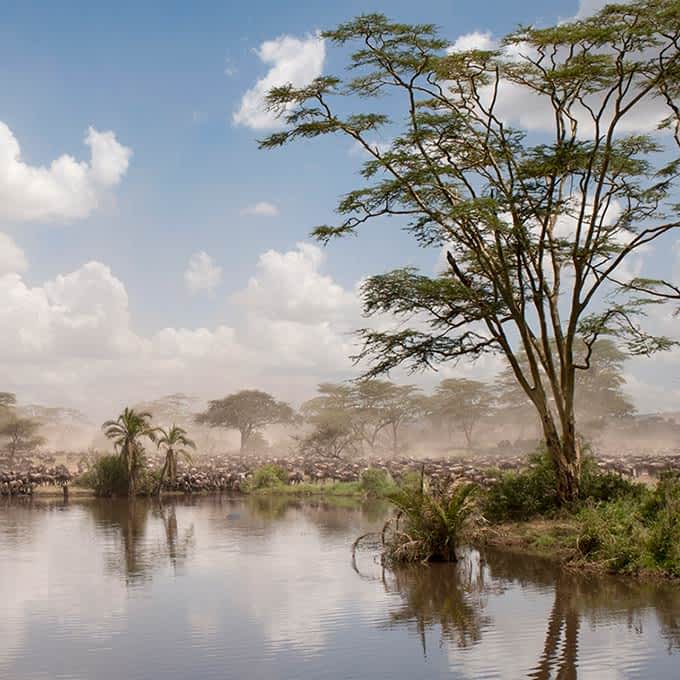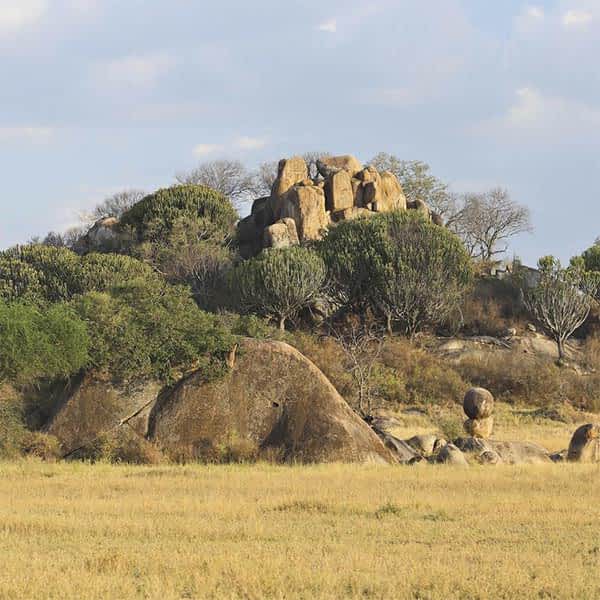Savannah vegetation & fires
However, your image is quite right: Serengeti National Park is made up mostly of savannah. Part of this savannah landscape are the grasslands, plains, kopjes (or koppies), marshes and woodlands. Savannah is a general term for semi-arid land: from woodlands to open grasslands and all mixtures of trees and grasses in between. One quarter of the world’s surface is covered by savannahs. Savannah land can support a higher density of animals than any other land type on earth. A common feature of savannah is that it is vulnerable to wildfires. Savannahs will occasionally burn, unless savannah grasses are completely consumed by animals; or if the savannah is frozen (temperate savannahs, such as tampas or steppes). With frequent fires and the potential to support massive amounts of animals, savannahs are dynamic landscapes that may transform rapidly.
Serengeti plains
The famous Serengeti plains cover the southern third of the national park: they form one reason the annual Great Migration occurs. The migration herd moves south to the plains following the rains after having spent time during the dry season in the much wetter north of the Serengeti.
During the rainy season, the shallow soil and two million ungulates convert the plains in a super-productive growing state. With ample food available, the female wildebeest produce and suckle their calves. Predators also seize the opportunity to fatten up in the wet season. With an abundance of young animals around, lions, cheetahs and hyenas live in a paradise of boundless food. As the dry season approaches, the seasonal waterholes dry up and the grass turns to yellow, then golden colour. This is the time for the wildebeest to begin the annual northward trek. Grant’s gazelle, warthog and ostrich remain behind to feed on the dried grasses on the plains. Only species that can do without water for lengthy periods can live on the plains during the dry season.
The Serengeti plains hold three distinct kinds of grasslands. The first is the short-grass plains, found around Ngorongoro and which extend into Serengeti National Park. Short-grass plains never burn because the massive herds eat most of the grasses and leave very little left to burn. Intermediate-grass plains is the second grass type and forms a crescent-shape west and north of the short-grass plains. The third grassland type is the long-grass plains found in the north of the Serengeti, but also around Seronera.
The shallow hardpan just under the surface of the plains catches rainwater and keeps it available for grasses, allowing it to grown dense. The incredible numbers of grazing animals in Serengeti National Park means that during the rainy season most of the grasses are eaten multiple times. If the grass is cut short by grazing animals, it will rapidly re-grow and will be higher in terms of nutrients and water when grown again. By crosscutting the grass short, and the subsequent process of the grass re-growing, the animals create a prime quality grazing lawn. Some grasses have adapted to this intense grazing pressure by growing horizontally along the ground, which reduces their exposure to being eaten by herbivores.
Why are there no trees on the plains?
During the Pleistocene age about 3 million years ago volcanic ash blown from the Ngorongoro highlands covered what are now the plains and as a result formed a calcareous hardpan less than a meter below the soil surface. This hardpan is impenetrable to roots and the shallow soil dries out quickly, making it impossible for trees to grow.
Woodlands
Woodlands are not as dense as forests. A sizeable amount of grass grows between the trees which exposes woodlands to seasonal bush fires. There are large grassland meadows in the woodland called 'mbugas’ in Kiswahili, which are often dotted with grazing animals. We can often find resident animals such as buffalo, elephant, topi, giraffe, warthog and impala in woodland areas.
There are three general types of woodland in the Serengeti. Velvet bushwillow / Terminalia mollis woodlands occur in the north-west of Serengeti National Park, the section of the park which receives the most rain. The trees here are large and old.
Vachellia (acacia) woodlands occur in the central and western parts of Serengeti National Park. There are 38 recorded species of vachellia in the woodlands of Serengeti. Of these, ten species make up more than half of the woodlands. The most common species is Vachellia Robusta, which grows on slopes and hilltops and can be distinguished by its dark, rough bark and feathery leaves.
Commiphora woodlands occur in the east of Serengeti National Park where there is the least rainfall: these woodlands are a mixture of vachellia and commiphora species. Commiphora species are not as fire resistant as their vachellia cousins.
Riverine forests
Riverine forests are a rare habitat within Serengeti National Park. Large rivers, while dry for most of the year, flow and flood during the wet season. Even during the dry season, the water table remains higher along the rivers. Because these areas hold more water, a dense forest of broad-leaved evergreen trees can grow. The riverine trees change the environment below them, making it an ideal habitat for other plants, insects, birds and animals.
Below the limbs of the riverine trees, the deep shade of the forest allows the soil and the air to remain moist. The forest floor is lined with shade-loving plants, while the trees themselves are covered with epiphytic plants, including orchids and masses of creeping vines. Fires cannot penetrate deep into these forests.
Further reading








